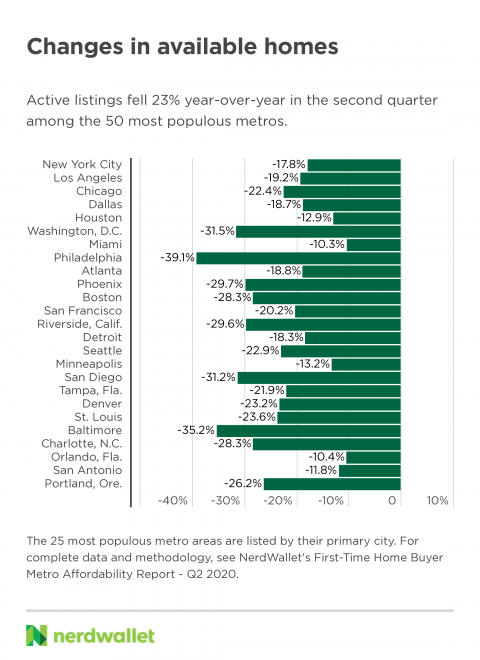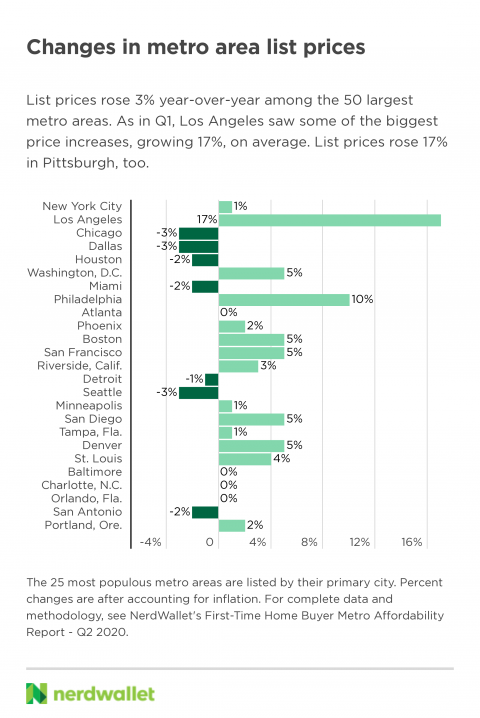First-Time Home Buyer Metro Affordability Report – Q2 2020
In the second quarter, modest price gains and low mortgage rates helped make buying possible for economically secure first-timers.

Some or all of the mortgage lenders featured on our site are advertising partners of NerdWallet, but this does not influence our evaluations, lender star ratings or the order in which lenders are listed on the page. Our opinions are our own. Here is a list of our partners.
Rising prices and plummeting listings — not to mention a global pandemic, record unemployment and recession — didn’t keep first-time home buyers from the market in the second quarter of 2020.
Ordinarily, in April, as the second quarter of the year begins, homebuying season is well underway, and inventory and prices are both rising toward a summer peak. But the second quarter of 2020 was unusual, to say the least.
Across the nation and among the most populous metropolitan areas, prices increased modestly in the second quarter and inventory became even more constrained in an already sparse market. Homeowners who’d been planning to sell reconsidered — though listings ticked up slightly in April, they fell sharply in May and June — and people who’d been thinking of buying, at a minimum, took a beat. But real estate professionals scrambled to implement virtual tours and finalize home purchases in parking lots, and market participants, particularly economically secure buyers, cautiously came out of hiding.
Lured in part by record low mortgage rates, first-time home buyers made up 35% of existing home sales in June, according to the National Association of Realtors, a higher share than in the past several years. For first-timers who have stability in the COVID-19 economy, and the wherewithal to stomach a highly competitive market, buying can still make sense.
In this quarterly report, we analyze median incomes in the first-time home buyer age range (25-44) compared with listing prices among the 50 most populous metro areas to come up with an affordability ratio. Budgeting for a home that costs roughly three times your annual income (an affordability ratio of 3.0) has been a rule of thumb for years, but first-time buyers often have to stretch beyond this to account for higher prices in metro areas and their lower incomes compared with repeat buyers. By weighing the affordability ratio versus home availability in the largest metro areas, we can get an idea of the conditions first-time buyers are facing when they set out to become homeowners.
By looking at both quarter-over-quarter and year-over-year changes, we can get a better picture of the effects of the COVID-19 economy on this year’s homebuying market. The former can provide insight into chronological market responses to the pandemic — our first-quarter affordability report captured data only through March, just the beginning of 2020’s atypical spring season. The latter can show how this year’s second quarter contrasts with similar periods in relatively normal times.
Click here for the Q1 2020 First-Time Home Buyer Metro Affordability Report.
Affordability down overall
Houses got slightly more out of reach for first-time home buyers in April through June, rising nationally from 4.5 times first-time home buyer income in the first quarter to 4.7 times in the second, and among the 50 largest metros from 5.1 to 5.2 times first-time buyer income. This trend is expected at this time of year. Home prices rise as the housing market heats up in the late spring and summer, but incomes don’t rise in a similar seasonal fashion. If anything, we might’ve expected a more dramatic change, but economic uncertainty on the part of sellers could have kept steeper list price increases at bay.
Nine of the 50 metros analyzed bucked this trend and saw affordability improve, but barely, sometimes only by a fraction of a percent.
The five most affordable metros for first-time home buyers in the second quarter include Pittsburgh (homes listed at 3.1 times first-time buyer income), St. Louis (3.4), Cleveland (3.5), Hartford, Connecticut (3.5), and Buffalo, New York (3.6). The least affordable, all in California, include Los Angeles, topping the list for the second quarter in a row, with homes listed at 12 times first-time buyer income; San Diego (9.0); San Jose (8.2); San Francisco (7.6); and Sacramento (6.6).
First-time buyer guidance: Homes get less affordable in late spring to early summer, and in this regard, the second quarter of 2020 is no different. First-time buyers who are economically secure may be able to make up for the rise in home prices by qualifying for record low mortgage rates. For example, the monthly payment on a $240,000 mortgage at 4.1% interest — roughly the average rate a year ago — is $1,160 per month, with $177,483 in interest over the 30-year life of the loan. However, at today’s rate of 3.1%, you’d pay $1,025 per month and $128,942 in interest over the life of the loan — nearly $50,000 in savings, total, and a $135 monthly break on your payment. Use a mortgage calculator to see what the difference in rates means for your budget.
Unseasonal scarcity in the second quarter
Even in years when supply is limited, an influx of homes hits the market during the spring homebuying season. Nationally, inventory grew 10% from the first to the second quarter of 2018, and 6% during that period last year. But in 2020, nationwide inventory dipped, albeit slightly, by about 2% quarter-over-quarter.
Half of the largest metros in the country saw a decrease in average active listings from Q1 to Q2, with the largest quarter-over-quarter declines in Cleveland (-17%), Louisville, Kentucky (-14%), and Memphis, Tennessee (-14%). However, other large metros saw remarkable increases: San Jose (+62%), Denver (+47%) and San Francisco (+39%), for example. These dramatic climbs helped push the average quarter-over-quarter change among the largest 50 metros to +4%.
Stepping back to look at year-over-year changes and how the supply of homes changed from Q2 2019, we found inventory dropped 23% among the 50 largest metros, on average, with 21 metros witnessing a decrease in available homes of 25% or more. Active listings in Las Vegas decreased 8%, the smallest quarterly drop of any metros analyzed and the only one of less than 10%.
We’ve been in a strong seller’s market for some time now, as the supply of homes hasn’t kept pace with demand. Having fewer homes hitting the market during the first months of the pandemic only stood to worsen the situation. A highly competitive market has grown even more so, and buyers without room to negotiate could be priced out entirely.
Click here to view a table featuring active listing data from all 50 metro areas analyzed.
First-time buyer guidance: If you’re at all uncertain about your economic security this year and buying would mean an increase in overall housing costs or leave you with no source of emergency funds, you may want to postpone your first home purchase. The low supply of homes means you’re less likely to find a home that checks all the boxes on your wish list. A loss of income, a bout of poor health or caring for a sick loved one could be overwhelming on top of a down payment, closing costs and the expenses associated with moving.
Home prices rise, as expected
We expect prices to rise as the housing market heats up, and if 2020 is sticking to the script in any way, this is it. From the first quarter to the second, national median list prices grew 7% in 2018 and 8% in 2019. This year, they grew 7% nationally, and slightly less, 5%, on average, among the largest metros, quarter-over-quarter.
Year-over-year growth was similar, rising about 3%, on average, among the 50 largest metros, after adjusting for inflation.
This overall relatively unremarkable growth in prices is one silver lining for first-time buyers. Having a dramatic shortage of homes for sale could drive prices up, but it doesn’t appear that sellers are listing their homes disproportionately higher than last quarter or than at this time last year. That said, list prices are only part of the story, and there’s little doubt that the lack of supply is driving hard bargaining in the negotiation process.
Click here to view a table featuring list price data from all 50 metro areas analyzed.
First-time buyer guidance: The price you see on a listing doesn’t tell the whole story. If you’re shopping in a seller’s market, be ready to act fast with an offer and compete with other buyers. You may end up paying more than list price, so shopping for homes listed under your max budget will give you a little more wiggle room if you find yourself in a bidding war.
Metro spotlight: Cincinnati, Cleveland and Columbus
Ohio has three metro areas in our analysis. It was also among the first states to begin canceling large events, declare a state of emergency and issue statewide restrictions to slow the spread of COVID-19. These factors may have played a role in changes in the local housing markets.
Cincinnati, Cleveland and Columbus were some of the more affordable populous metros in the second quarter, with home prices averaging 4.7, 3.5 and 4.5 times the median first-time home buyer income, respectively. Even so, all three showed rising prices compared with the same period last year. Median home prices in Cincinnati rose 12%, the third-highest increase of all metros analyzed.
But the big story in these Ohio metros is a lack of availability. Though inventory among all metros analyzed fell 23%, on average, compared with last year, it fell 34% in Cincinnati, 33% in Cleveland and 25% in Columbus.
When comparing this quarter’s listed homes with last quarter’s, we find a similarly dramatic decrease. Cleveland saw the largest quarter-over-quarter dip in active listings among all metros analyzed: inventory fell 17% from the first quarter. Active listings fell 10% in Cincinnati and 7% in Columbus at the time of year when most markets would typically be flooded with home listings.
The one thing saving buyers from being completely locked out of homeownership: affordability. So while finding a home will prove tricky due to a lack of inventory, homes on the market are more likely to be within budget for first-time buyers.
METHODOLOGY
Monthly median list price and list count figures are from monthly Inventory Data from the Realtor.com residential listings database as of June 2020. The nominal list prices were adjusted to June 2020 dollars using the U.S. Bureau of Labor Statistics’ Consumer Price Index. All monthly median figures were compiled into quarterly averages.
When comparing new quarterly data with affordability data in the previous quarter, we used figures adjusted to the period in which they were first analyzed. For example, first-quarter list prices and incomes were not adjusted to Q2 dollars when comparing quarter-over-quarter changes. This was done for consistency’s sake between the previous report and the current one.
The median age of first-time home buyers is 33, according to the National Association of Realtors’ 2019 Profile of Home Buyers and Sellers. Estimated income for first-time home buyers was derived from the U.S. Census Bureau’s 2018 American Community Survey median household income for householders ages 25-44 — the range likely to include most first-time home buyers — and escalated to June 2020 dollars using the Bureau of Labor Statistics’ Employment Cost Index.
The 50 metros selected were updated to reflect the latest (2019) population estimates. San Juan, Puerto Rico, is among the 50 most populous metros but was excluded from the analysis due to insufficient inventory data.
Interpret metro rankings with caution. Due to margins of error in income data and rounding, there may be overlap in affordability ratios.



